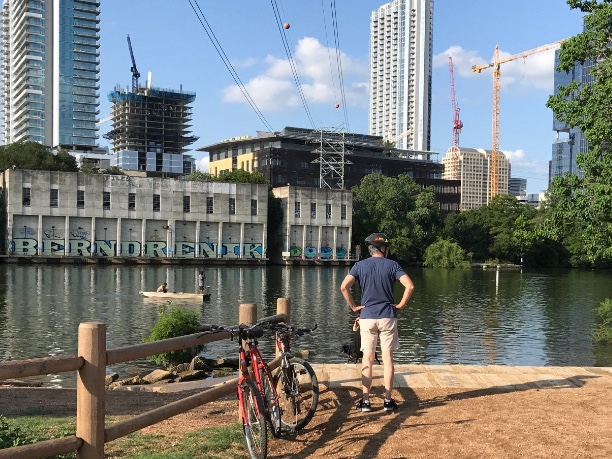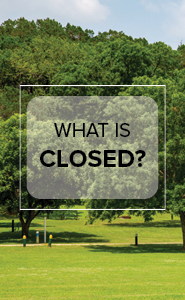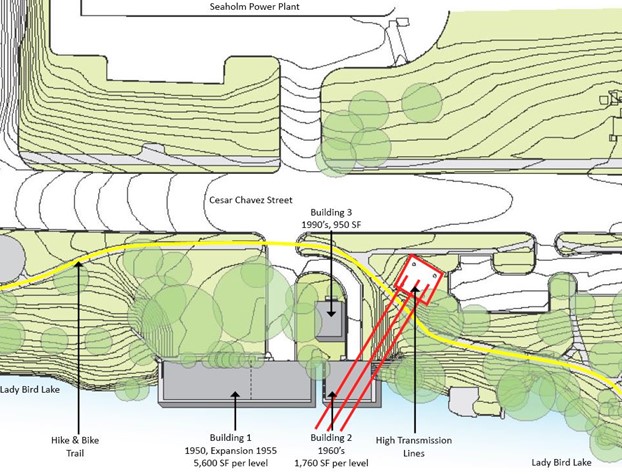The Seaholm Intake Facility is an iconic Art Deco building that once served as the pump house for the Seaholm Power Plant, which operated until 1989. In 1996, Austin City Council authorized the decommissioning of the plant and all the associated buildings in preparation for future adaptive reuse.
In the fall of 2016, the Austin Parks and Recreation Department (PARD) and key partners discussed strategies to achieve the greatest public benefit for the Seaholm Intake and surrounding parkland that could best harness the energy and resources of the non-profit and philanthropic sector. A collaborative planning study led by internationally recognized architecture and urbanism firm Studio Gang began in June 2017 and was completed in 2018. The study provides PARD and The Trail Conservancy (TTC) with the programming, phasing, operational, and financial model needed to develop a world-class public facility that protects and celebrates the architectural and historical significance of the Seaholm Intake Facility and the surrounding parkland.

The plan, which relies heavily on public input via online platforms, stakeholder meetings, and public open houses, has served as a roadmap for future park improvements and the repurposing of the decommissioned Seaholm Intake structures for public use and recreation. The plan is ambitious and broken into several phases that will incrementally bring the entire Seaholm Waterfront site to life.
As of September 2022, Phase 1 has been completed. Phase 1, funded through Hotel Occupancy Tax revenue and 2018 bond funding, restored the main building to a level that allows small groups to visit the site safely with the support of City or TTC guides, but does not yet support large-scale events or programming. The scope of this phase included building exterior cleaning and removal of graffiti, window restoration, enclosing large openings in the floor with the installation of new flooring atop a modular steel system, noise reduction with the installation of new acoustic ceiling tiles, new interior and exterior lighting, ADA accessibility improvements, and a new roof. An accessory building was also updated, providing restrooms and a staging area.
Phase 2 will bring the building to life with the addition of public access, amenities, programming, and staffing. Phase 2 upgrades include finishing out the interior of the building to include a café and community space, revitalizing the main lawn to add more park space and landscaping to mitigate the street noise, and creating a platform for water access to the building. The Trail Conservancy, in partnership with PARD, launched a $15,000,000 capital campaign in 2023 to fund Phase 2 and will begin the construction of this phase once the campaign goal has been reached. Future phases of the facility could include realigning the hike-and-bike Trail with a boardwalk around the lakefront of the building.
Seaholm Facility Photo Gallery
- Programming the Seaholm Intake Facility Lawn
-
The City of Austin Parks and Recreation Department and The Trail Conservancy have planned a variety of programs that will allow safe, managed access to the space and surrounding parkland until Phase 2 is completed. These current programs will include, but are not limited to:
- Music on the Trail series
- Flow & Thrive fitness series
- Scavenger Hunt
- Ecological restoration volunteer events
Austin Parks and Recreation Department
- Historic Tours and Open Houses
- Exterior Film Permitting and Commercial Photography
- Contacts for Programming
-
- Programming in conjunction with the Trail Conservancy: events@thetrailconservancy.org
- Programming in conjunction with PARD: PARKnershipsinfo@austintexas.gov
- Film Permits: reservations@austintexas.gov
- Project, Construction or Planning information:
- Phase 1 Rehabilitation, contact Christina Bies, Project Coordinator, by email
- Seaholm Waterfront Planning
-
Austin Parks Foundation (APF), The Trail Conservancy (TTC), and the City of Austin Parks and Recreation Department (PARD) completed a planning study in 2017 for the future of Seaholm Waterfront, the historic Seaholm Intake structure and its surrounding parkland. The study, completed by internationally recognized architecture and urbanism firm Studio Gang, reveals a potential concept for future park improvements and the repurposing of the decommissioned Seaholm Intake structures for public use and recreation.
Background
The Seaholm Intake facility is an iconic Art Deco design and was the pump house for the Seaholm Power Plant. The Seaholm Power Plant, a City-owned retired power generation facility, was designed by Burns & McDonnell Engineering Co. and built of cast concrete in two phases in 1950 and 1955 by Odom Construction. Seaholm Intake is part of that overall complex. The Seaholm Power Plant complex represents a strong civic presence in the cityscape of downtown Austin and showcases a unique period of American Art Deco municipal architecture and Public Works engineering. Seaholm operated as a power plant until 1989. In 1996, Austin City Council authorized the decommissioning of the plant and all the associated buildings, in preparation for future adaptive re-use. The Seaholm Intake Facility is located on the banks of Lady Bird Lake and the Ann and Roy Butler Hike-and-Bike Trail.
About the Project
The planning phase, which began in May 2017, was designed to provide PARD and the City of Austin with a highly adaptable, long-range vision for the historic Seaholm Intake structure and underutilized surrounding parkland by developing the Seaholm Intake into a public facility, while respecting the historic significance of the structure. The study area spanned between the Pfluger Bridge and Shoal Creek, and from the lake’s edge to Cesar Chavez.
Project Scope
The study’s goal was to develop a highly adaptable, long-range vision for the historic Seaholm Intake structure and underutilized surrounding parkland. Work on early phases including safety requirements and code compliance improvements was completed in 2022 and the other phases and amenities will be built out in the coming years. The preferred design concept for the adaptive re-use of the building features an open and flexible space that can be used any day by the public, or periodically for events, and on occasion for large gatherings with the ability to serve food and beverages. Additional features of the proposed plan include the addition of support structures, flexible lawn space, multiple water access points, trail improvements and an amphitheater. Several important principles guided the planning process and potential design of the Seaholm Waterfront including embracing and preserving the historic integrity of the building, engaging with the local community and experts, restoring and diversifying the ecology in the area, and building sustainable principles into the design and operational models.
Objectives
The goal was to develop a long-range vision for the project with particular focus on the programming model to:
- develop a public and civic facility;
- identify a phased approach to the project so that work can begin in the near future;
- and build out the project in the coming years.
Precedent Projects and Qualifications
The project team identified precedent projects and key attributes to be considered:
- Experience with similar projects in similar settings
- Experience understanding projects in the public realm and specifically parklands
- Experience with developing feasibility studies encompassing economic, environmental and cultural vitality
- Experience with public participation and outreach.
With these attributes in mind, Studio Gang was identified to move forward to lead the effort. An internationally recognized architecture and urbanism firm founded by MacArthur Fellow Jeanne Gang, Studio Gang has developed such landmark urbanism projects as Civic Commons, a set of design strategies and techniques that communities can use to renew their public assets, created as part of the national initiative Reimagining the Civic Commons; two boathouses on the Chicago River; the Nature Boardwalk and Pavilion at Chicago’s Lincoln Park Zoo in Chicago; and the framework plan for Northerly Island, a public park and former airfield on Lake Michigan.
- Seaholm Waterfront Community Engagement
- Seaholm Intake Facility - Phase 1
-
Background
The Seaholm Power Plant, a City-owned retired power generation facility, was designed by Burns & McDonnell Engineering Co. and built of cast concrete in two phases in 1950 and 1955 by Odom Construction. Seaholm Intake is part of that overall structure. The Seaholm Power Plant represents a strong civic presence in the cityscape of downtown Austin and showcases a unique period of American Art Deco municipal architecture and Public Works engineering. Seaholm operated as a power plant until 1989. In 1996, Austin City Council authorized the decommissioning of the plant and all the associated buildings, in preparation for future adaptive re-use. The Seaholm Intake Facility is located on the banks of Lady Bird Lake and the Ann and Roy Butler Hike-and-Bike Trail.
The planning phase began in May 2017 and was completed in 2018.
Phase 1 Rehabilitation Description
The Seaholm Intake Facility required extensive renovations after sitting vacant and decommissioned as a power plant building for decades. The focus of the Phase 1 Rehabilitation was to provide the necessary upgrades to make the building usable, such as exterior cleaning, interior safety, and ADA accessibility improvements. In addition, Building 3 was retrofitted as a support structure for events at the intake facility. These renovations allow for rejuvenation and activation of the space in the short-term, while preparations for the next phase of the Seaholm Waterfront Plan are developed.
Community engagement for Phase 1 Rehabilitation was collected by email and webpage updates. Phase 1 included the necessary upgrades for the building to be safe, and code compliant as outlined in the Council-approved plan for the Seaholm Waterfront. Extensive engagement was completed as a part of the planning process, as well as a robust series of Boards, Commissions and City Council approvals. All Phase 1 work was granted approval by the Historic Landmark Commission and City of Austin Historic Preservation Office. The City executed a construction contract with Balfour Beatty Construction, LLC to complete the work as selected through a Competitive Sealed Proposal solicitation in Spring 2021. Construction commenced in September 2021 and was completed in 2022.



